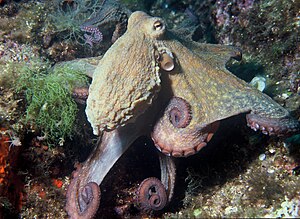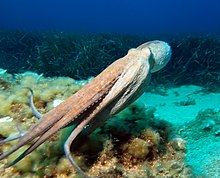Octopuses
| Octopuses | ||||||||||||
|---|---|---|---|---|---|---|---|---|---|---|---|---|

Common octopus ( Octopus vulgaris ) |
||||||||||||
| Systematics | ||||||||||||
|
||||||||||||
| Scientific name | ||||||||||||
| Octopoda | ||||||||||||
| Leach , 1817 | ||||||||||||
| Familys | ||||||||||||
|
The octopuses ( order Octopoda) are a subgroup of the eight-armed cuttlefish (Vampyropoda) within the cuttlefish (Coleoidea). Their closest relatives are the cirrus octopus and the vampire squid-like (Vampyromorpha). The cirrus-bearing octopuses have only recently been separated from the octopus in the narrower sense.
Octopuses are considered to be the most intelligent molluscs , with their intelligence being compared to that of rats . Octopuses are usually very shy, but curious and prove to be very capable of learning in experiments.
Surname
German name
In the technical language , the name is always a masculine : the octopus . In the vernacular , the female form is the octopus uses.
The name Krake was adopted from Danish - Norwegian into German and could stand for "uprooted tree", as the arms protrude like roots in all directions. Duden specifies dialect Norwegian as the source language; the further origin of norwegian krake or kraken is unclear according to the Duden.
Scientific name
The scientific name "Octopoda" (literally "eight-footed") refers to an important characteristic of the octopus. It should be noted that the species-rich genus Octopus is only one of several genera within the order Octopoda (see section Systematics ).
In the plural, only the spelling “Octopoda” is a clear designation of the order. The Germanized spelling “octopus” (with k ) with the plural forms “octopods” and “octopus” mostly refers to octopuses in general, but this is not always clear. The likelihood of confusion is increased by the fact that the octopus is not a specific characteristic of the octopus, but the common characteristic of a superordinate group, the eight-armed cuttlefish (Octopodiformes). The use of the German name "Kraken" for the order Octopoda is therefore advantageous. The meaning of "octopus" - unlike that of "octopus" and "octopod" - is usually clear.
habitat
Most octopuses are ground dwellers ( benthal ). The shallow sea benthic species can also survive and move outside the water for some time. They often go to tide pools to hunt for crabs , snails and other animals.
anatomy
Octopuses have eight arms (four pairs of arms). The arms carry sessile suction cups that have no reinforcement rings. Octopuses usually have a favorite arm that they use more often than the others.
You have completely reduced the original shell of the cephalopod . The females of the paper boats ( Argonauta spec. ), Which build an outer shell as an egg container from a secretion from their arm glands, are an exception .
The octopus' body, the coat , is usually sac-like. Octopuses have a multi-part heart with a main heart and two gill hearts .
Octopuses are characterized by their highly developed nervous system , which occupies a top position among invertebrates . They have very good lens eyes , which, in contrast to those of vertebrates , are built eversely and thus point directly to the light with the sensory cells of the retina . The arms, and especially the suction cups, have strong nerves and large ganglia and can move independently of the brain .
The color change of the octopus is based on a three-layer distribution of chromatophores in the skin, which are also connected to many nerves. Octopus bimaculoides and some other species can sense light with their entire body surface.
Behaviors
Locomotion
Octopuses use their arms to move about on the ocean floor. When fleeing, the octopuses use the recoil principle . They push the water out of their mantle cavity through a funnel and escape through the recoil with their bodies first.
Because they do not have an internal skeleton, octopuses are extremely agile and can slip through even the narrowest crevices and holes. The mobility made especially the Thaumoctopus mimicus world famous.
Ability to learn
The octopus brain is very powerful; thus they deal with many maze problems more efficiently than most mammals . The small octopus Amphioctopus marginatus collects coconut shells in order to use them later as a dwelling - a unique example of a systematic approach among invertebrates. However, octopuses' ability to learn is limited. Although they can imitate the behavior of conspecifics, this occurs almost only in captivity, as they are loners.
Skills once learned are not passed down from generation to generation because invertebrates do not form parent-child relationships like birds or mammals. Instead, invertebrates ensure the survival of offspring by producing an extraordinarily large number of offspring. Octopuses reach a maximum age of three years.
- Octopus opens a container with a screw cap
Reproduction and development
As with the other cephalopods, internal fertilization takes place in the separate-sex species , mating takes place through the third left arm, which is specially converted in the males, which is also known as the Hectocotylus Jussila . This is inserted into the mantle cavity of the female and transfers a capsule filled with sperm, the spermatophore . The sperm cells are then released through an explosive bursting of the spermatophores and fertilize the eggs.
In the paper boat , the dwarf males' hectocotyl detaches completely with the spermatophore and is able to find and fertilize a female even over long distances. In addition, since the male, at 2 cm in size, is considerably smaller than the female (around 10 cm), the severed arm was scientifically described before the male itself, but incorrectly as a parasitic nematode in the female's mantle cavity.
Octopuses do not form larvae , their embryos grow as yolk discs on the large eggs ( discoidal furrowing ). In many species, the eggs are closely guarded by the mother animals. All octopuses reproduce only once in a lifetime, the animals die a few weeks to a few months later.

Octopuses and humans
Octopuses are generally harmless and not aggressive. The octopus bite, in all known cases due to provocation on the part of the person concerned, is usually painful, but harmless.
With the exception of Hapalochlaena maculosa and Hapalochlaena lunulata , octopuses have only a very weak poison, if at all. The bite of the two aforementioned blue-ringed species (also known as blue -ringed octopuses ), on the other hand, is not only slightly painful, but also very poisonous. The poison maculotoxin of the blue ringed octopus is almost identical to the tetrodotoxin of the puffer fish . The bitten person feels weak shortly after the bite and feels a tingling sensation in the face. This is followed by numbness, nausea with vomiting and symptoms of paralysis. These symptoms of paralysis quickly worsen and affect the respiratory center at an early stage. The person concerned is always fully conscious, but can no longer articulate himself due to the paralysis. Without intensive medical treatment, such poisoning can be fatal. There is no known antidote to the poison. The victim must be ventilated until the effects of the poison wear off and the victim begins to breathe on their own again. Accidents with blue-ringed octopuses are rare. From 1950 to 1995 only eleven accidents are documented. Of these, however, two accidents were fatal.
The area of legends includes reports that large octopuses can strangle people with their tentacles or even pull ships into the depths, see Kraken (mythology) .
Some octopus species are used in a variety of ways, especially in Mediterranean cuisine and in Asia, see octopus (food) .
Paul the octopus achieved particular media awareness , as an oracle animal during the 2010 soccer world championship he correctly “predicted” the outcome of all soccer matches that were tapped.
Systematics
Among the octopuses, two basic types were previously distinguished on the basis of their possession of fins , the cirrata with fins ( cirrus-bearing octopus ) and the incirrata (octopus i. E. S.) without fins. The former mainly inhabit the deep sea and are good swimmers. They have recently been raised to the rank of an independent order, as this group was not included in the original definition of the Octopoda. In contrast, these are found mainly in relatively shallow water on the seabed; these include the most famous species. Both groups are classified as monophyla , which are opposed to the vampire squid- like (Vampyomorpha).
|
Octopoda (octopus without fins and cirrus)
|
literature
- Thomas Berthold, Theo Engeser: Phylogenetic analysis and systematization of the Cephalopoda (Mollusca). In: Negotiations of the Natural Science Association Hamburg. NF, 29, Hamburg 1987, pp. 187-220. ISSN 0173-749X
- David B. Carlini, Richard E. Young, Michael Vecchione: A molecular phylogeny of the Octopoda (Mollusca: Cephalopoda) evaluated in light of morphological evidence. In: Molecular Phylogenetics and Evolution. 21 (3), San Diego 2001, pp. 388-397. ISSN 1055-7903
- Mark Norman: Squid Guide - Octopuses, Argonauts, Sepias, Squids, Nautilids. Year, Hamburg 2000, ISBN 3-86132-506-3 .
- Richard E. Young, Michael Vecchione: Evolution of the gills in the Octopodiformes. In: Bulletin of Marine Science. 71 (2), Coral Gables, Florida 2002, pp. 1003-1017. ISSN 0007-4977
- Paul Gerhard Heims: octopuses, monsters, sailor's yarn. Legends and superstitions on the high seas. Edited and edited by Michael Kirchschlager, Arnstadt / Festa, Leipzig 2006, ISBN 3-86552-055-3 .
- Sy Montgomery : rendezvous with an octopus. Translated from the American by Heide Sommer. Mare Verlag, Hamburg 2017, ISBN 978-3-86648-265-4 .
Web links
- http://www.weichtiere.at/Kopffuesser/octopus.html Robert Nordsieck: Kraken (Octopodidae).
Individual evidence
- ↑ a b Cf. Krake at Duden online
- ↑ See Wolfgang Pfeifer (Red.): Etymological Dictionary of German. ed. from the Central Institute for Linguistics, Berlin (East) 1989, p. 921.
- ↑ Entry “Octopus” under Duden online .
- ↑ Octopus on shore leave. Video. In: Spiegel online. 2011.
- ↑ Eye-independent, light-activated chromatophore expansion (LACE) and expression of phototransduction genes in the skin of Octopus bimaculoides
- ↑ Could cuttlefish “see” with their skin?
- ^ Julian K. Finn, Tom Tregenza, Mark D. Norman: Defensive tool use in a coconut-carrying octopus. , In: Curr. Biol. 19 (23), 2009, pp. S1069-1070. doi: 10.1016 / j.cub.2009.10.052





